According to Jim Bolinger (private communication; 5/9/2002), the first
use of the term Argus used for a scientific device occurred in
the 1975 book by Arthur C. Clarke entitled Imperial Earth.
Jim told me that he was aware of the Greek mythology behind the name Argus,
namely that Argus was a guard being having 100 eyes and could see in all
directions at once. Tom van Horne, a volunteer with the Radio Observatory,
also was aware of Argus in Greek mythology and mentioned it to Bob Dixon.
Jim and Bob Dixon discussed this mythology and Bob decided to use the
name Argus for his concept of a radio telescope that could detect signals
('see') in all directions at once (i.e., over a hemisphere since no
radio waves could penetrate through the center of the earth).
Bob Dixon's concept of an Argus radio telescope involved using a large
number of small independent antenna elements, each element having its own
complete receiver and analog-to-digital (A/D) converter to change
the continuously varying (analog) and highly amplified output signal
from the receiver into a stream of digital data that would be collected
and analyzed by one or more digital computers. Although each antenna
element would be independent of the others, all such elements would
receive the same local oscillator (L.O.) signal(s) to downconvert the
band of observing frequencies to a much lower band of frequencies so
that the data could be analyzed conveniently. The common L.O. signal(s) to
all receivers allows the phase information to be preserved; this is critical
for the operation of an Argus radio telescope. Another important concept of
an Argus array is the use of physically small antenna elements so that the
beam pattern covers the entire visible hemisphere. This allows an Argus to
'see' the entire visible sky at once and to permit the use of either short
integration times to catch transient events (but doing so for an observing
period of many hours) or else very long integration times to recover signals
buried in the noise.
During discussions between Jim Bolinger and Bob Dixon, it was decided that
Jim should build the prototype of a 'radio camera'; the term 'Argus' was not
yet in common use, although the concepts of the 'radio camera' were
essentially the same as those of 'Argus'. This prototype was to serve as a
'proof of concept' instrument, and indeed it did.
Jim states the purpose of his thesis as follows:
"The purpose of this paper is to explore the possibility of applying
modern signal processing and beamforming theory to the construction of a
large unfilled aperture antenna, which would be capable of forming many
beams simultaneously; thereby completely eliminating the look discrimination
problem and permitting transient events to be easily detected. Such a system
would be capable of forming a near real-time image of the radio sky, hence
the term 'Radio Camera'. Other advantages include very long signal
integration time, up to 12 hours, and increased immunity to interference
compared to a single antenna, which is an inherent characteristic of phased
arrays due to the noise being noncoherent at each element, with respect to
the signal. Also, once the signals are digitized it would be possible to
compensate for receiver differences and array imperfections, thereby
obtaining a 'perfect' system over a very wide bandwidth. By use of a
Fourier transform, or similar process, the spectrum of the signals may be
derived allowing the full signal characteristics to be studied."
Jim's comment above about the integration time being up to 12 hours needs
to be clarified. Depending on the latitude of the observatory and the
declination of the celestial radio source, the integration time per day
could be anything in the range from 0 hours to 24 hours, neglecting
atmospheric effects. For example, for an observatory in the northern
hemisphere, sources near the south celestial pole will never rise above the
horizon, sources on the equator will be visible for 12 hours, and sources
near the north celestial pole will be visible all the time (i.e., for 24
hours every day).
Jim covers the theory of beamforming and fundamentals of sampling theory;
they will not be covered here as they are outside the scope of this article.
Before Jim describes the prototype radio camera, he lists the following five
design criteria (listed in order of decreasing significance):
- The beamforming technique must be entirely general and applicable to
any frequency or bandwidth.
- The beamforming technique must have sufficient resolution to enable
individual signals to be identified easily.
- The non-computer related hardware must be minimized, consistent with
criterion number 1. As much as possible must be done in software.
- The frequency chosen must have at least two easily detectable signals
present at all times. To avoid confusion, they must be fixed in terms of
direction.
- The antenna array design should be such that, with conventional
beamforming techniques, the angular resolution would be greater than that
required for criterion 2.
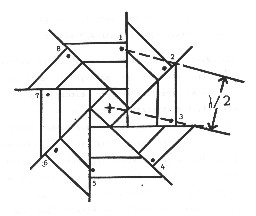 The antenna array constructed for the prototype is diagrammed in the
figure to the left. It had 8 elements, uniformly spaced around a circle
of radius 0.9235 meters (1/2 wavelength for the observing frequency of
162.4 MHz). Individual elements were quarter wave monopoles. These 8
monopoles projected above a circular ground plane made of 1-inch poultry
fence having a radius of 3/4 wavelength. The decision to use 8
elements was based on Jim's initial plan for a computer with a 16-channel
A/D converter; quadrature sampling was to be used which required 2
channels per element. Other parameters of the radio camera included:
system bandwidth = 7027 Hz; number of beams = 36; beam spacing = 10
degrees in azimuth; beam size between first nulls = 90 degrees in
azimuth; and sampling rate = 37,277 Hz.
The antenna array constructed for the prototype is diagrammed in the
figure to the left. It had 8 elements, uniformly spaced around a circle
of radius 0.9235 meters (1/2 wavelength for the observing frequency of
162.4 MHz). Individual elements were quarter wave monopoles. These 8
monopoles projected above a circular ground plane made of 1-inch poultry
fence having a radius of 3/4 wavelength. The decision to use 8
elements was based on Jim's initial plan for a computer with a 16-channel
A/D converter; quadrature sampling was to be used which required 2
channels per element. Other parameters of the radio camera included:
system bandwidth = 7027 Hz; number of beams = 36; beam spacing = 10
degrees in azimuth; beam size between first nulls = 90 degrees in
azimuth; and sampling rate = 37,277 Hz.
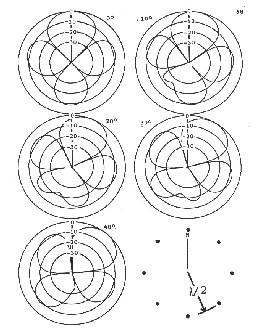 The figure to the left shows the predicted beamshape of the array. There
were a total of 36 beams, spaced every 10 degrees in azimuth. This figure
shows the beams for azimuth angles of 0 degrees, 10 degrees, 20 degrees,
30 degrees, and 40 degrees, respectively (left to right, top to bottom). All
other beams are rotations and/or reflections of these beams.
The figure to the left shows the predicted beamshape of the array. There
were a total of 36 beams, spaced every 10 degrees in azimuth. This figure
shows the beams for azimuth angles of 0 degrees, 10 degrees, 20 degrees,
30 degrees, and 40 degrees, respectively (left to right, top to bottom). All
other beams are rotations and/or reflections of these beams.
Jim decided that by using a fixed frequency and observing a set of fixed
beacon signals arriving from known directions, the cost of the system could
be kept to a minimum. After monitoring several frequencies, he decided to
use 162.400 MHz, one of seven frequencies allocated to the National Weather
Service weather radio stations.
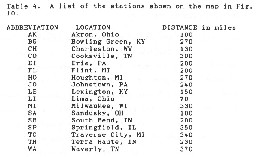
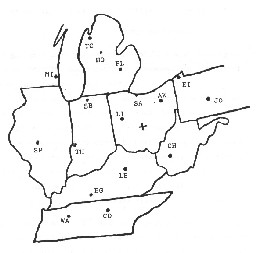 The table at the far left and the corresponding map to its right show
the 17 stations within 400 miles of Columbus, Ohio that operate at
162.400 MHz. Jim expected to detect many of these stations.
The table at the far left and the corresponding map to its right show
the 17 stations within 400 miles of Columbus, Ohio that operate at
162.400 MHz. Jim expected to detect many of these stations.
Jim next describes the hardware and the computer software used. Discussion of
these is beyond the scope of this article.
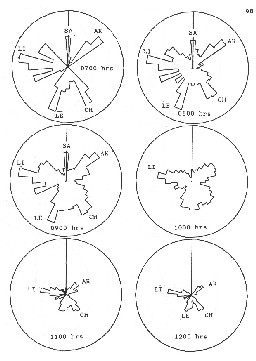 The diagram at the left is a sample of one of the eight pages of results Jim
published in his thesis. It is for May 16, 1988; it shows 6 plots with
separations in time of 1 hour (times are local). It is obvious that several
of the weather stations were consistently detected. [Remember to click on this
diagram to bring up a larger version.]
The diagram at the left is a sample of one of the eight pages of results Jim
published in his thesis. It is for May 16, 1988; it shows 6 plots with
separations in time of 1 hour (times are local). It is obvious that several
of the weather stations were consistently detected. [Remember to click on this
diagram to bring up a larger version.]
In conclusion, Jim Bolinger's Radio Camera was an excellent prototype of an
Argus-type radio telescope. It accomplished 'proof of concept', at least for
some of the concepts. One area that it was not able to test was a
2-dimensional directionality (i.e., both azimuth and altitude, or the
celestial coordinates of right ascension and declination). However, given the
limitations in computing power and electronic hardware (and money) at the
time, Jim's work was well worthwhile.
![[NAAPO Logo]](NAAPOsm.jpg)
![[NAAPO Logo]](NAAPOsm.jpg)